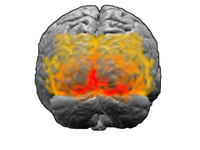
Photo from wikipedia
Any transmission of vocal signals faces the challenge of acoustic interferences such as heavy rain, wind, animal or urban sounds. Consequently, several mechanisms and strategies have evolved to optimize signal‐to‐noise… Click to show full abstract
Any transmission of vocal signals faces the challenge of acoustic interferences such as heavy rain, wind, animal or urban sounds. Consequently, several mechanisms and strategies have evolved to optimize signal‐to‐noise ratio. Examples to increase detectability are the Lombard effect, an involuntary rise in call amplitude in response to masking ambient noise, which is often associated with other vocal changes such as call frequency and duration, as well as the animals’ capability of limiting calling to periods where noise perturbation is absent. Previous studies revealed vocal flexibility and various audio‐vocal integration mechanisms in marmoset monkeys. Using acoustic perturbation triggered by vocal behaviour, we investigated whether marmosets are capable of exhibiting changes in call structure when perturbing noise starts after call onset or whether such effects only occur if noise perturbation starts prior to call onset. We show that marmosets are capable of rapidly modulating call amplitude and frequency in response to such noise perturbation. Vocalizations swiftly increased call frequency after noise onset indicating a rapid effect of perturbing noise on vocal motor production. Call amplitudes were also affected. Interestingly, however, the marmosets did not exhibit the Lombard effect as previously reported but decreased call intensity in response to noise. Our findings indicate that marmosets possess a general avoidance strategy to call in the presence of ambient noise and suggest that these animals are capable of counteracting a previously thought involuntary audio‐vocal mechanism, the Lombard effect. These findings will pave the way to investigate the underlying audio‐vocal integration mechanisms explaining these behaviours.
Journal Title: European Journal of Neuroscience
Year Published: 2020
Link to full text (if available)
Share on Social Media: Sign Up to like & get
recommendations!